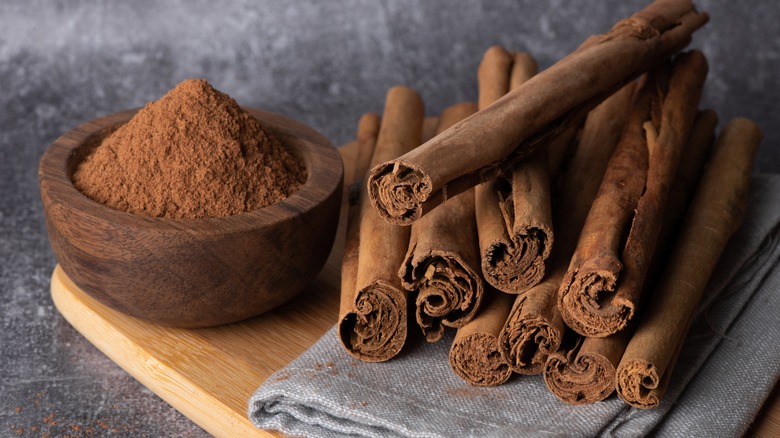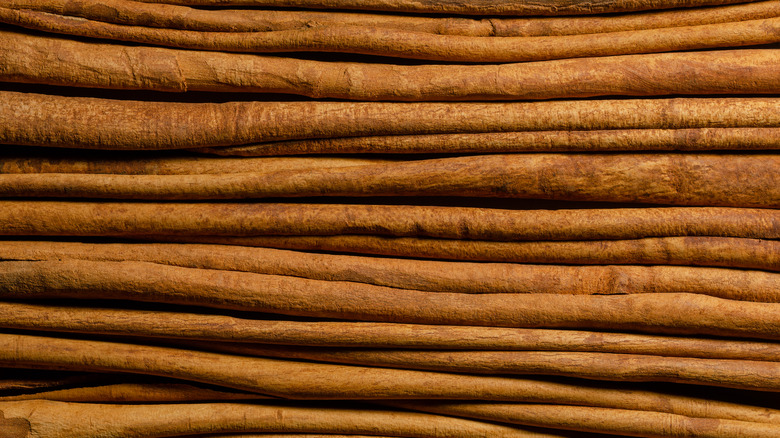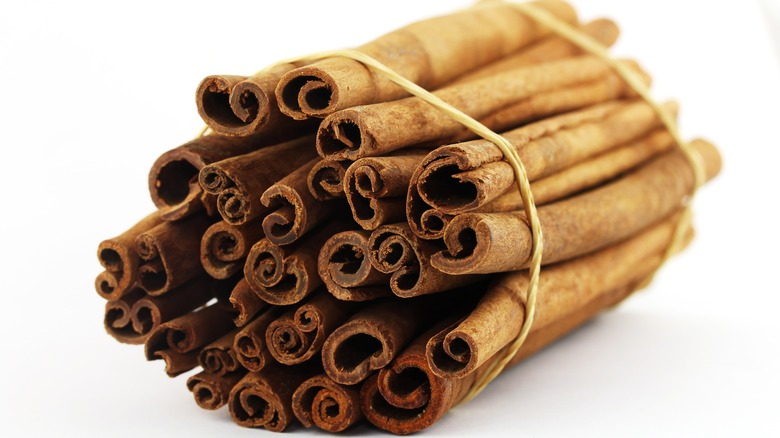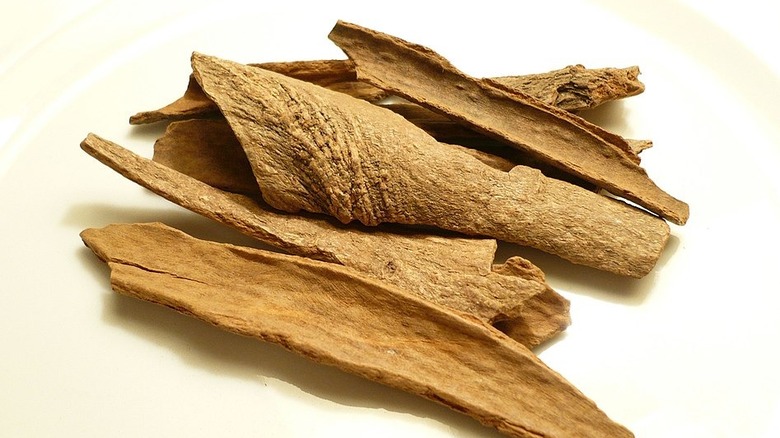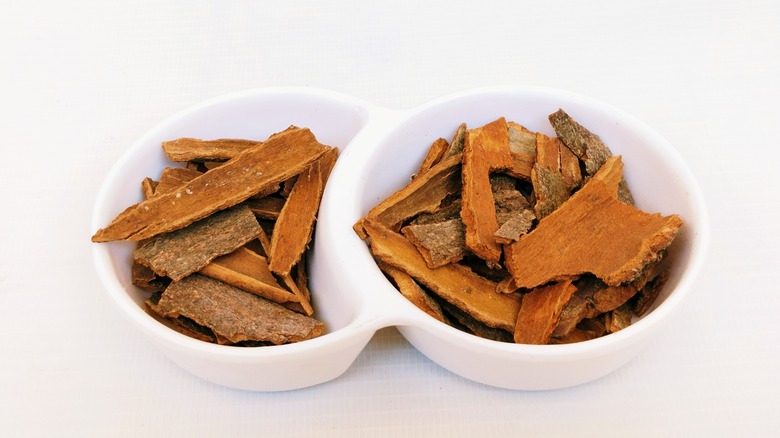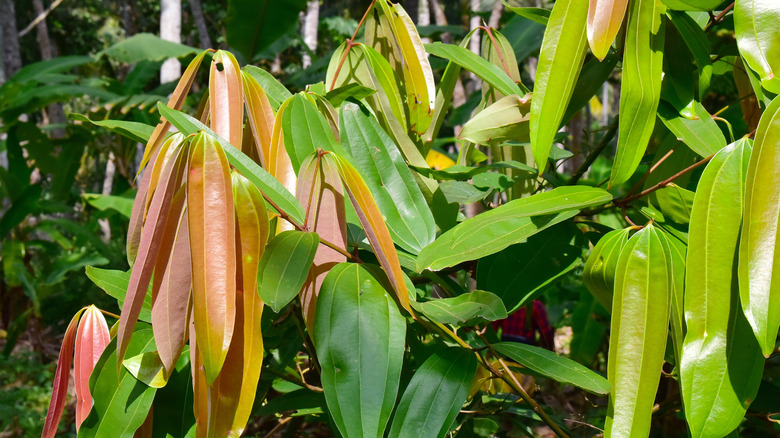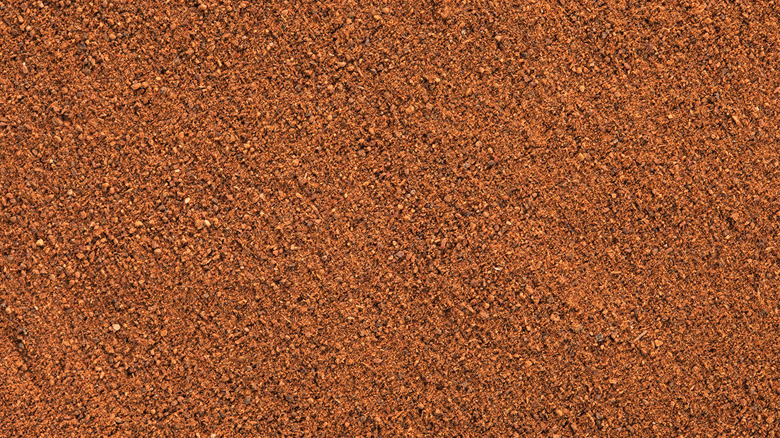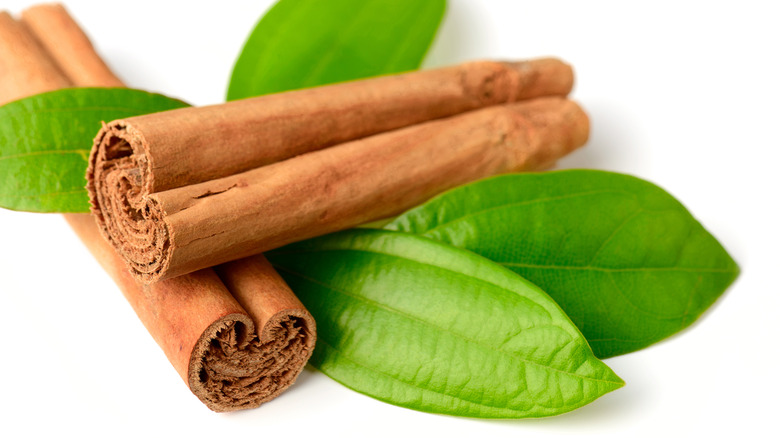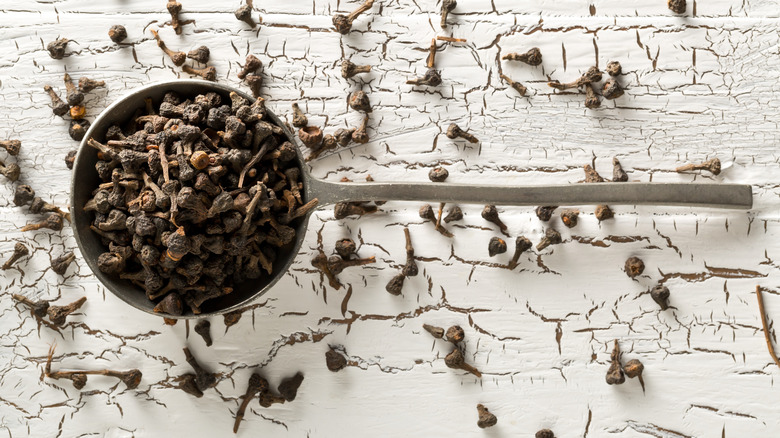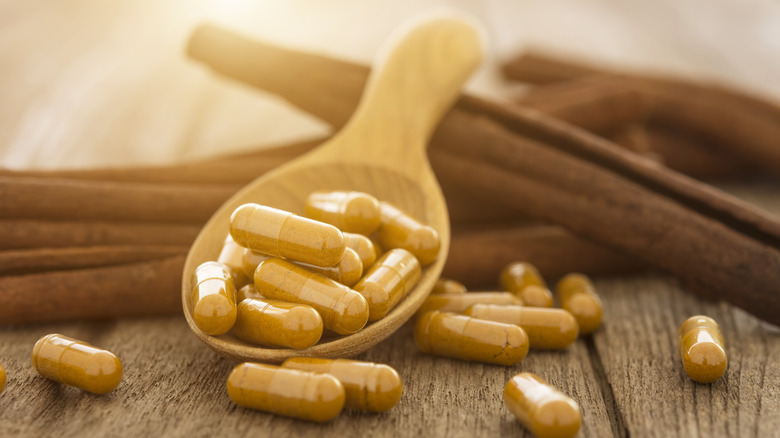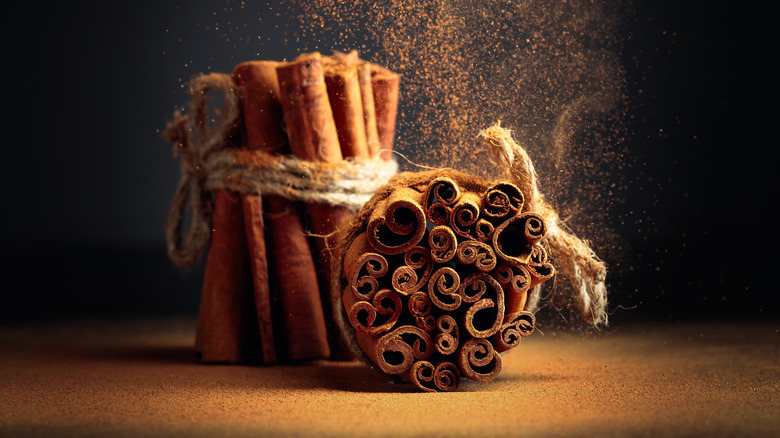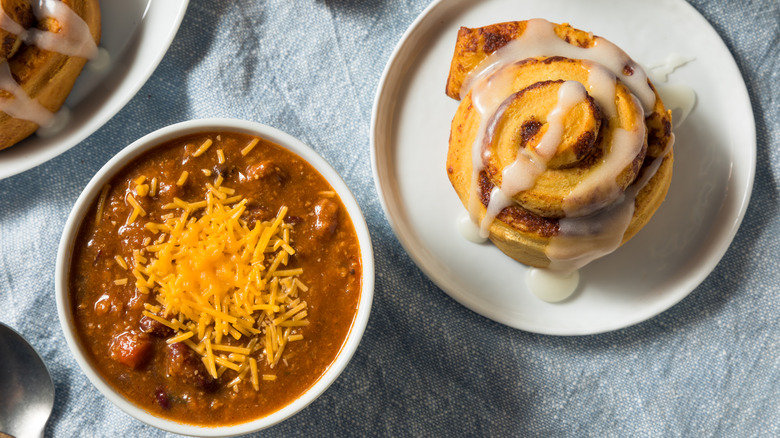The Ultimate Guide To Different Types Of Cinnamon And Their Uses
When most people hear the word cinnamon, they probably think of the sweet ground spice they mix with sugar and sprinkle on toast. It's an utterly ordinary part of the kitchen — though no less beloved for it — and the kind of thing you automatically assume everyone has in their spice cabinet. But cinnamon is a lot more complicated than you might expect. People have been using this sought-after spice since 3,000 BCE. Arab traders brought the spice from Asia to Europe, creating millions of cinnamon devotees along the way.
What is it about this spice that makes it so irresistible? Cinnamon is made from the inner bark of Cinnamomum trees, which belong to the laurel family (Lauraceae). This means cinnamon is related to bay leaves, sassafras, and even avocados. Not only are there multiple species of cinnamon trees, cinnamon can refer to more substances than just the classic ground spice. The tree's leaves and even the dried flower buds are the source of all sorts of different cinnamon creations. Have you ever heard of cinnamon capsules? How about cinnamon oil? Did you know that there are important differences between Ceylon cinnamon, Saigon cinnamon, and wild cinnamon? If not, get ready — you're about to go on a deliciously-scented journey into the heart of this superb spice. This is the ultimate guide to different types of cinnamon and their uses.
Cassia
Cassia, or Chinese cinnamon, comes from the bark of the Cinnamomum cassia tree (also known as Cinnamomum aromaticum), an evergreen tree native to southern China. The fragrant bark and leaves are the most commonly used parts of these unique trees. Essential oils made from them are often used as flavoring and aromatic agents for home goods like candles and food. You can swap in cassia for other cinnamons, but notably, it doesn't taste as sweet as the cinnamons you might be used to. As a result, it's good for savory dishes, like curries and pickles, and is often part of Chinese five spice powder.
Cassia has long been used in traditional Chinese medicine. In fact, a report by Chengdu University of Traditional Chinese Medicine's School of Pharmacy states, "Modern studies have confirmed that C. cassia has a wide range of pharmacological effects, including anti-tumor, anti-inflammatory and analgesic, anti-diabetic and anti-obesity, antibacterial and antiviral, cardiovascular protective, cytoprotective, neuroprotective, immunoregulatory effects, anti-tyrosinase activity, and other effects." While more studies on Chinese cinnamon are still needed, this is hugely interesting research of note to any cinnamon fan.
If you're really into cinnamon, you can even add cassia to your container garden. People in tropical climates can grow them outdoors, while those in colder areas can place cassia in greenhouses.
True cinnamon
True cinnamon goes by many names. Botanically, it is Cinnamomum verum or Cinnamomum zeylanicum, but it's often known as Ceylon cinnamon or Mexican cinnamon. Even though it's called true cinnamon, it isn't technically truer cinnamon than other cinnamons, as they're all part of the Cinnamomum genus. Regardless, the name sticks. True cinnamon is native to India, Java, and Malaysia. Ceylon cinnamon has long been used in Ayurvedic medicine to treat many ailments, from colds to headaches to menstrual pain. Some research from the University of Colombo suggests that Ceylon cinnamon is safer in higher quantities than cassia because it contains less of an anticoagulant called coumarin.
So, what does true cinnamon taste like? This specific cinnamon is subtler, sweeter, and more floral than many other cinnamons, though it's often used in similar ways in the kitchen. True cinnamon's sweet flavor pairs well with desserts, making it an excellent choice for cozy winter treats. Get your basic on and sprinkle some of this spice on your PSL — it couldn't be a more perfect pairing. If you're really into true cinnamon's flavor, you can grow it as a houseplant. Since most cinnamon in U.S. grocery stores is actually cassia, this might actually be the surest way to enjoy true cinnamon.
Padang cassia
Cinnamomum burmannii is native to Southeastern Asia and Indonesia. While commonly called Padang cassia, it isn't technically from the cassia tree, though it's lumped into that culinary category. You can also find this cinnamon under the names Indonesian cinnamon or Korintje cinnamon. It's the most commonly sold cassia cinnamon in the U.S., which means it's the flavor most Americans associate with cinnamon. What distinguishes that particular flavor? Padang cassia is a sweet, strong spice with a hint of heat — not so much that it troubles the tongue, but enough to bring pepper to mind. There's also a distinct note of fragrant wood. Padang is another good cinnamon for fall and winter treats, but make sure you don't overcook it — it gains an unpleasant aftertaste. Notably, Padang has a shelf life of six months to a year if you store it somewhere cool and dark in an airtight container.
Interestingly, Padang cassia is considered an invasive plant in Hawai'i. It's a prolific grower, falls easily, and attracts many pests.
Saigon cinnamon
Saigon cinnamon is another cinnamon sold and known culinarily as cassia. Cinnamomum lourieroi also goes by the names Vietnamese cinnamon, Vietnamese cassia, Saigon cinnamon, and royal cinnamon. Vietnamese cinnamon bark often comes from younger trees; notably, the dried, unripe fruits (known as buds) are also processed and widely used. One especially delicious use for it is in cordial.
Saigon cinnamon is one of the most interesting varieties, scientifically speaking. At 25%, Cinnamomum lourieroi has the highest cinnamaldehyde ratio in its essential oil, compared to other cinnamons. Cinnamaldehyde is the compound that gives cinnamon its characteristic flavor. No wonder this pungent cinnamon pairs well with chocolate and makes for fabulous cinnamon rolls — its vibrant flavor always ensures it plays the starring "roll" (sorry, we can't resist) in any dish. Try Saigon cinnamon in a classic cinnamon bread recipe if you can snag some, where it'll be sure to shine.
Unfortunately, along with its high concentration of cinnamaldehyde, Saigon cinnamon also contains a lot of coumarin, which can cause liver damage in high quantities. While general culinary usage poses little risk, don't load up on desserts made with this cinnamon is you're also taking supplements derived from it.
Malabar cinnamon
Malabar cinnamon, also known as Cinnamomum citriodorum or Camphora citriodora, is from Sri Lanka and India's southern Western Ghats mountain range. This cinnamon is a true stunner, smelling distinctly of lemongrass. It has a long history of being used as both a spice and a medicine, specifically to treat stomach problems. Its unique lemongrass smell comes from the high percentage of citronellol found in Malabar cinnamon extract. While it's not the only plant that boasts this compound, research says it's the first cinnamon species discovered to contain it. In fact, more than 65% of its leaf oil is comprised of citronellol, while the petiole extract contains about half that. Citronellol is used as a flavoring and scent agent, and can be distinguished by its floral, rosy scent. It functions well as an insect repellant. You can also find citronellol in black tea, eucalyptus, geranium, and rose oils.
Wild cinnamon
Another cinnamon of many names — including Cinnamomum malabatrum, Cinnamomum eucalyptoides, Cinnamomum malabathricum, Cinnamomum ochraceum, and Cinnamomum rheedii — wild cinnamon's uses are primarily in traditional medicine. It's harvested and sold in regions where it's endemic: the seasonally dry tropical areas of western and southern India. Wild cinnamon is often sold as "Tamalapatra," and is a highly sought-after commodity frequently found in spice markets. It's also a uniquely hardy cinnamon, capable of recovering from significant damage so long as its basal wood remains intact.
So, what is this celebrated cinnamon good for? People use it for pretty much everything, including wounds, hemorrhoids, colic, coughs, fevers, tumors, and heart issues. A 2013 study published in the Research Journal of Pharmacy and Technology found that Cinnamomum malabatrum leaves have valuable anti-inflammatory properties. You might not be putting wild cinnamon in your desserts any time soon, but it's still worthy of your attention.
Cinnamon sticks
Cinnamon sticks are the dried inner bark of cinnamon trees that have been set out to dry. As this process takes place, the bark curls and forms what are called quills. The cinnamon sticks we know and love are cut from these quills. Cinnamon sticks can be harvested from any cinnamon tree and come in all sorts of varieties. But maintaining this old tradition is no easy task.
The process is usually conducted during the monsoon season (though it can be done year-round). Because the spice is gathered from the tree's inner bark, cinnamon peelers have to be able to gather cinnamon without damaging the other bark. In Sri Lanka, where true cinnamon originates, the job of peeling cinnamon became inextricably bound up with Portuguese and Dutch colonialism. Traditions regarding the process were swept away in the pursuit of profit. Though these days have passed, cinnamon peeling endures. Some tourists pay top dollar to watch the process up close.
Now that you're looking at your cinnamon sticks with new eyes, how should you use them? If you're into home décor, they make excellent additions to candles or potpourri. If you'd prefer to cook with them, they're great for infusing both food and beverages.
Ground cinnamon
Ground cinnamon is pretty much what it sounds like: cinnamon bark that has been ground into powder. (You might even see ground cinnamon sold as cinnamon powder.) Ground cinnamon is the form most often used in baking. Like cinnamon sticks, it doesn't denote a cinnamon species, and it can be made from the bark of any cinnamon tree. However, in the United States, the majority of unlabeled cinnamon you'll find is cassia.
Here's a question you might have asked yourself at some point: Does cinnamon go bad? Like all ground spices (as opposed to whole), the shelf life of ground cinnamon isn't incredibly long. To keep your cinnamon fresher longer, store it in a cool, dark, and dry place. If you keep your cinnamon this way, it won't ever truly go bad — it'll just lose flavor over time. However, the general rule of thumb is this: Ground cinnamon is likely good for a year past its sell-by date, while cinnamon sticks last about three to four years. So what are you waiting for? Get some buttered toast ready — it's time to make some cinnamon sugar.
Cinnamon oil
Food-grade cinnamon oil is often used in gum and baked goods, and as a preservative. Most of the cinnamon oil you'll find on the market is made from either Cinnamomum cassia or Cinnamomum verum. However, the latter is more expensive and less common. Cinnamon essential oil is most often made from the trees' bark, leaves, and sometimes roots. Molecularly, the oils are pretty different. But how do they compare in terms of smell? The most notable distinction between them is that oil extracted from leaves has a lighter scent than oil extracted from bark.
According to research by Universiti Malaysia Kelantan, cinnamon oil may fight certain bacteria and fungi and be a mood enhancer. However, as Healthline notes, those with liver conditions and anyone on diabetes medication should talk to their doctor before using cinnamon oil. Too much of it — especially cassia cinnamon oil — can pose health risks.
Cinnamon leaves
Cinnamon leaves — which are sometimes called Indian bay leaves or tej patta — can come from different cinnamon trees. Commercial ones tend to come from Cinnamomum vernum. Most of these fragrant leaves are red before they mature into a rich green color. They're usually sun dried before being further processed, and are often used to make essential oil. Such oil has slightly different properties from the oils made from cinnamon bark and flowers.
Cinnamon leaves have a lush and warm fragrance. It's definitely recognizable as cinnamon, but it's also significantly less sweet. In cooking, they make a great alternative to bay leaves in dishes such as stew, chili, and similarly slow-cooked meals. They're also great in rice pilaf and curries. Jamaican cuisine often uses cinnamon leaves in jerk marinades and cornmeal porridge. You can also boil them into tea, if you'd like a cinnamon-flavored drink that's a bit less dessert-ish. Store your cinnamon leaves in an airtight container somewhere cool, dry, and dark for up to six months.
Cinnamon buds
Cinnamon buds closely resemble cloves, and taste more nuanced and intense than cinnamon bark. While sometimes called cinnamon flowers, these buds are actually collected after the tree finishes flowering and the fruit is beginning to emerge, and are then dried. While you can (and should) add cinnamon buds to hot food, don't let it reach a boiling temperature — this compromises their unique flavor. You can use them much as you would use black pepper. For cold food, the buds can be ground, either in a spice grinder or a pepper mill. For hot food, the buds should be added in the final minutes of cooking.
Cinnamon buds are often used in Indian cooking, and can be found in many masala mixes. They are also a key ingredient in German pfeffernusse cookies. Keep your cinnamon flowers in an airtight container in a cold, dry, and dark place to keep them at their best.
Cinnamon capsules
While cinnamon is undoubtedly delicious, it's also distinguished by its many health benefits. It's no surprise, then, that the beloved spice is available in capsule form, so that people might reap its health benefits. Research conducted at the University of Sydney's School of Medicine indicates that cinnamon has powerful anti-inflammatory properties. The potent spice might also prove helpful in the fight against metabolic diseases. There's even some indication that cinnamon could help reduce high blood pressure. In light of this research, cinnamon capsules are an attractive prospect to many health-conscious folks.
Cinnamon has some potentially adverse side effects as well, however. Because cassia has a very high amount of coumarin, it can be harmful if you have too much. Some varieties and concentrations are also genuinely spicy and can irritate people's mouths. Talk to your doctor before adding cinnamon capsules to your health regimen.
How to find quality cinnamon
So how do you know if you're buying good cinnamon? The first test is pretty standard for all spices: Make sure the cinnamon you buy isn't discolored or moldy. You shouldn't be able to see any foreign objects, such as insects, other plant matter, or rodent droppings. Beyond that, cinnamon should smell like cinnamon. This might seem obvious, but artificial cinnamon flavors are more common and detectable than you might assume — they tend to smell like generic holiday spice. Different cinnamons also have specific qualities to look out for. For instance, when buying cassia cinnamon, look for its telltale reddish tint. When it comes to true cinnamon (aka Ceylon cinnamon), look for a dark brown color and softer bark. You should also consider the packaging date, and whether the product is organic or fair trade, depending on personal preference.
Most of the cinnamon available in U.S. grocery stores — especially if it isn't labeled — is cassia. If you're looking for a rarer type of cinnamon, or even true cinnamon, you may need to look online or in a specialty market. You might be lucky enough to have a brick-and-mortar spice store nearby, but even if you're not, online emporiums like Burlap & Barrel have you covered. Keep in mind that there will be a price difference here: Rarer cinnamon can cost upwards of four times what regular grocery store brands charge.
Surprising ways to use cinnamon
Most of us have had cinnamon rolls, snickerdoodles, and gingerbread. While those are undoubtedly fantastic ways to use cinnamon, they're definitely not the limits of its uses. Cinnamon can elevate many savory dishes as well, for one thing. If you've ever had Moroccan food, you've experienced what cinnamon can add to a main dish. Try using cinnamon as a garnish for flaky Moroccan pastilla, or as a supporting note in fish stew.
A pot of chili may not be where you expect to find cinnamon, but that's precisely where you should try it. The warming spice is so well-suited to this American staple, some Midwesterners eat cinnamon rolls with their chili. Speaking of soups (or is it stews?), cinnamon is an integral part of Vietnamese phở broth and many curries, such as Sri Lanka kukul mas, a well-marinated chicken curry. And that's just the beginning of the cinnamon adventure; from coffee to Mexican cocoa to Chinese five spice mixes, there's a whole world of cinnamon recipes to explore .
